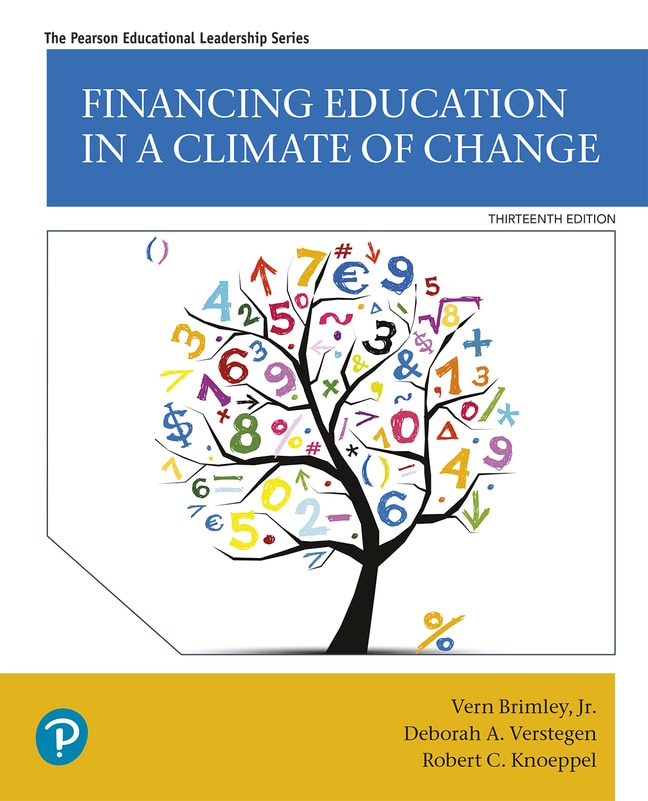
Financing Education in a Climate of Change, 13th edition
Your access includes:
- Search, highlight, notes, and more
- Easily create flashcards
- Use the app for access anywhere
- 14-day refund guarantee
$10.99per month
Minimum 4-month term, pay monthly or pay $43.96 upfront
Learn more, spend less
-
Listen on the go
Learn how you like with full eTextbook audio
-
Find it fast
Quickly navigate your eTextbook with search
-
Stay organized
Access all your eTextbooks in one place
-
Easily continue access
Keep learning with auto-renew
Overview
Financing Education in a Climate of Change presents the most up-to-date information in the dynamic field of school finance. Easy-to-understand tables and figures, thought-provoking assignments, and practical budget and accounting examples help you gain a firm understanding of all facets of financing education.
The 13th Edition adds information on classic and current topics. It looks at the economics of education; recent court decisions; 50-state comparison tables; state taxes; and the ongoing debate about school vouchers, tax credits, church-state issues, and charter schools.
Published by Pearson (July 15th 2021) - Copyright © 2020
ISBN-13: 9780137524990
Subject: Educational Leadership
Category: School Finance
Overview
1. The Economics of Education
Education as Human Capital
Creation of Wealth and Education
Education: An Important Industry
A Public-Sector Responsibility
Economics and Social Progress
Economic Benefits of Education
Noneconomic Benefits of Education
Cost-Quality Relationship in Education: Does Money Matter?
2. The Need for Adequate Funds
Adequacy and the Factors Impacting It
Education Deserves High Priority
The Public Wants Good Schools
The Increasing Costs of Education
Spending on Education and the Size of the Enterprise
Impacts on the Cost of Providing an Adequate Education
What is the Cost of an Adequate Education?
A Failure to Provide Opportunity and Associated Costs
Society Suffers the Effects of Poor Education
3. Financing Education Equitably
Inequalities in Financing Education
Equity: An Objective of School Finance Reform
Measures of School District Wealth
Income Tax
Historical Influences on Equity
The Equalization Principal
Improving State Equalization Practices
Foundation Programs and Variations
The Impact of Average Daily Attendance on Equity
The Changing Climate and Current School Finance Practices
4. Patterns for School Finance Systems
Developing Patterns
Determining the Best Finance Plan
Full State Funding
District Power Equalization
Property Reassessment and Local District Revenues
Emphasis on Weighting Factors
Principal Types of Weights
5. Sources of Revenue
Education -- Financed by Government
The Taxation System
Characteristics of a Good Tax System
Taxes for Education
Income Tax
Sales Tax
Property Tax
Excise Tax
Severance Tax
Other Funding Sources
Potential New Taxes
6. Education: A State Function
Early Development of State Responsibility
Development of Decentralized Educational Systems
Development of School Finance Policies
Developmental Stages of School Finance
The Varying State Programs
State Ability to Support Education
7. Eroding Local Control
Changing Rural-Urban Influence on Education
Basic School District Administrative Units
The Administration of Local School Districts
Advantages of Local Control
Fiscal Independence of School Districts
Trends in Local Taxation Practices
Measures of Local Taxpaying Ability
Local, State, and Federal Tax Responsibility
8. Federal Interest in Education
Federalism
Historical Role of the Federal Government
US Department of Education
Constitutional Role
Block Grants, Categorical Aid, and General Aid
Federal Expenditures
Fiscal Advantages and Disadvantages
Increased Government Service
The Future of Federal Aid to Education
9. The Influence and Climate of the Courts
Three Waves of School Finance Litigation
The First Wave of School Finance Litigation
The Second Wave of School Finance Litigation
The Third Wave of School Finance Litigation: A Shift from Equity to Adequacy?
Second-Generation Adequacy Cases
Impact of School Finance Litigation over Time
Pressure for Reform
Finance Reform or Tax Reduction?
Court Decision Guidelines
10. Public Funds and Nonpublic Schools
History
Educational Choice
The Law and Church-State Relations
11. Financing School Facilities
The Need
Early Capital-Outlay Programs
Capital-Outlay Court Decisions
State Support
Equity in Financing Educational Facilities
The Federal Government and Capital Outlays
Capital-Outlay Finance Plans
School Bonding Practices
Other Alternatives
Impact Fees
Sales Taxes
Future Policies for School Facilities
12. Administering the District and School Budget
Evolution of Budgetary Practices
Development of a Systems Approach to Budgeting
District and School Budgetary Approaches
District-Level Budgetary Practices
Administering the District Budget
School/District Coordination
Budgeting at the School Level
Challenge of Leadership
13. Accounting and Auditing
The School Accounting System
The Changing Accounting Environment
Comprehensive Annual Financial Report
Characteristics of Governmental (Fund) Accounting
Encumbrance Accounting
Cost Accounting
Accrual Accounting
Receiving and Depositing Funds
Expending School Funds
Auditing
Protecting School Funds
14. Business Aspects of the School Community
Increased Safety Hazards
The Business Office
Supplies and Equipment
Purchasing
Supply Management
Risk Management
Transportation
School Food Services
15. Human Resources and School Finance
The Expanded Role of Human Resources Administration
Teacher Compensation
Certification
Pay-for-Performance -- Merit Pay
Additional Issues
Teachers and School Finance
The Changing Assignments of Teachers
Administrative and Supervisory Salaries
Noncertified Personnel Salaries
Payroll Policies and Procedures
Government Influence
16. The Road Ahead in School Finance
The Future of Public School Finance
Unresolved Issues
Some Characteristics of Educational Structure
School Finance Goals
The Challenge
Your questions answered
When you purchase an eTextbook subscription, it will last 4 months. You can renew your subscription by selecting Extend subscription on the Manage subscription page in My account before your initial term ends.
If you extend your subscription, we'll automatically charge you every month. If you made a one‑time payment for your initial 4‑month term, you'll now pay monthly. To make sure your learning is uninterrupted, please check your card details.
To avoid the next payment charge, select Cancel subscription on the Manage subscription page in My account before the renewal date. You can subscribe again in the future by purchasing another eTextbook subscription.
When you purchase a Channels subscription it will last 1 month, 3 months or 12 months, depending on the plan you chose. Your subscription will automatically renew at the end of your term unless you cancel it.
We use your credit card to renew your subscription automatically. To make sure your learning is uninterrupted, please check your card details.